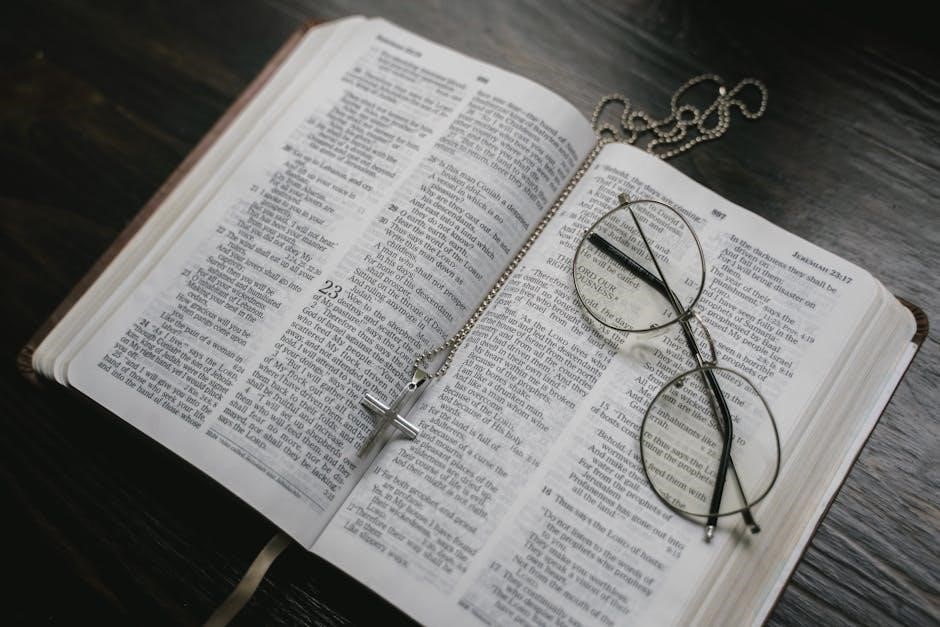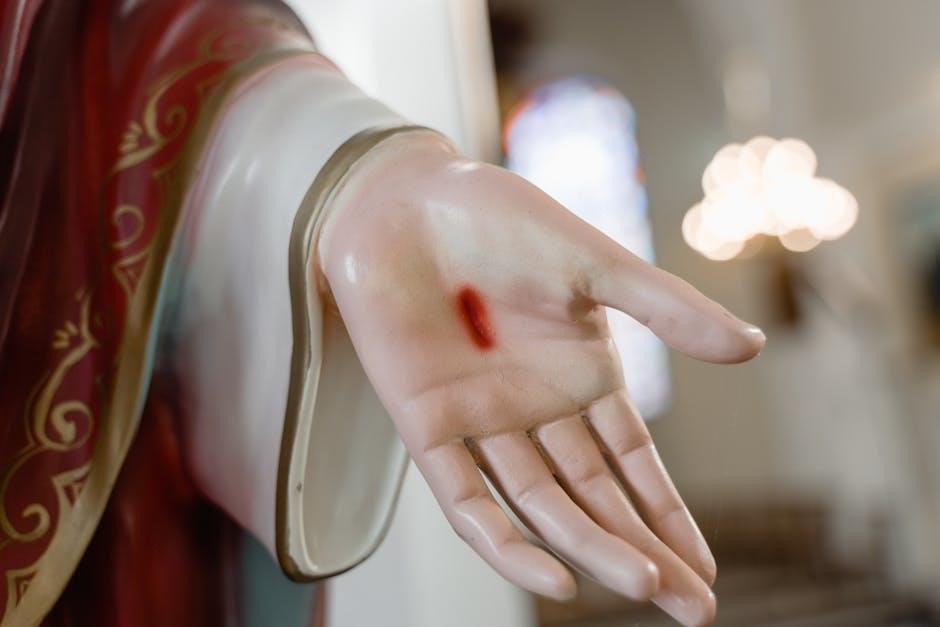The Bible is rich in symbols, each carrying deep spiritual meanings that unlock its teachings. Symbols like the cross, dove, and lamb reveal divine truths, guiding believers in faith and devotion.
Overview of the Importance of Symbols in the Bible
The Bible uses symbols to convey deep spiritual truths, making complex ideas accessible. Symbols like the cross, dove, and lamb are central, representing sacrifice, peace, and redemption. These symbols bridge the divine and human, offering insights into God’s plan. They enrich biblical narratives, aiding believers in understanding scripture. Symbols also connect Old and New Testaments, revealing continuity in God’s message. Studying them deepens faith and illuminates spiritual principles, making symbols indispensable for meaningful Bible study and personal devotion.
Why Understanding Biblical Symbols is Essential for Deep Study
Understanding biblical symbols is crucial for grasping the deeper meanings of Scripture. Symbols like the cross, dove, and lamb convey complex spiritual truths, bridging the divine and human. They illuminate connections between Old and New Testament themes, revealing God’s overarching plan. Ignoring these symbols can lead to a superficial understanding of the Bible. By exploring their meanings, believers gain richer insights, fostering spiritual growth and a more effective application of biblical teachings in daily life and ministry.

Common Symbols in the Bible
The Bible contains countless symbols, such as the cross, lamb, lion, bread, wine, water, and light/darkness, each carrying profound spiritual significance and enriching the biblical narrative.
The Cross: Its Significance and Meaning

The cross is a central symbol in Christianity, representing Jesus Christ’s sacrifice and redemption of humanity. It embodies divine love, forgiveness, and the victory over sin and death. Through the crucifixion, the cross signifies the ultimate act of obedience and the fulfillment of God’s plan for salvation. As a universal symbol of faith, the cross reminds believers of the profound sacrifice made for their spiritual freedom and eternal life.
The Lamb: A Symbol of Sacrifice and Redemption
The lamb is a profound biblical symbol, representing sacrifice and redemption. In the Old Testament, the lamb was a substitute for sin, as seen in the Passover. Jesus Christ is often referred to as the “Lamb of God,” who willingly offered Himself as a sacrifice for humanity’s sins. This symbol underscores God’s love and the ultimate act of redemption, providing salvation for all who accept it. The lamb’s purity and humility further emphasize its significance in Christian theology and worship.
The Lion: Representing Strength and Divine Authority
The lion is a powerful biblical symbol, embodying strength, courage, and divine authority. In Revelation, Jesus is called the “Lion of Judah,” highlighting His sovereignty and victory. The lion’s roar symbolizes God’s voice, commanding respect and inspiring awe. This imagery reflects God’s protective nature and righteous judgment, as well as His rule over creation. The lion’s majesty underscores the awe-inspiring power of God, reinforcing themes of trust and reverence in His divine plan and authority.
Bread and Wine: Symbols of Communion and Covenant
Bread and wine are profound biblical symbols, deeply rooted in sacred rituals and covenantal relationships. Bread represents life, sustenance, and community, often linked to God’s provision, as seen in the manna and the Passover. Wine symbolizes joy, sacrifice, and the shedding of blood, reflecting divine covenant and atonement. Jesus transformed these elements during the Last Supper, instituting them as emblems of His body and blood, signifying the New Covenant. Together, they embody remembrance, spiritual nourishment, and unity with God and His people.
Water: Representing Life, Purification, and Spirit
Water is a universal symbol in the Bible, representing life, purification, and the presence of the Holy Spirit. It signifies spiritual rebirth, as seen in baptism, where it cleanses and renews believers. Rivers, like the Jordan, symbolize divine provision and transformation. Water also embodies God’s judgment, such as in the flood, and His mercy, as in the parting of the Red Sea. Jesus referred to Himself as “living water,” offering eternal life and spiritual refreshment, emphasizing water’s profound role in salvation and spiritual growth.
Light and Darkness: Contrasting Good and Evil
Light and darkness are powerful symbols in the Bible, contrasting good and evil. Light represents God’s presence, truth, and righteousness, while darkness symbolizes sin, ignorance, and separation from God. Jesus is often called the “Light of the World,” guiding believers away from spiritual darkness. This duality is seen in Genesis, where God separates light from darkness, and in Revelation, where eternal light triumphs over darkness. The struggle between light and darkness reflects the spiritual battle between obedience to God and rebellion against Him, emphasizing the need for believers to walk in the light of His truth.

Animals as Symbols in the Bible
Animals in the Bible symbolize various divine concepts, such as peace, sacrifice, and evil. The dove represents the Holy Spirit, while the serpent signifies temptation and deception.
The Dove: A Symbol of Peace and the Holy Spirit
The dove is a profound biblical symbol, representing peace, innocence, and the Holy Spirit. In Genesis, a dove brought an olive leaf to Noah, signifying the end of the flood and God’s promise of peace. At Jesus’ baptism, the Holy Spirit descended in the form of a dove, symbolizing divine presence and purity. The dove’s gentle nature and calm flight further emphasize its association with peace and holiness, making it a powerful and enduring symbol in Christian theology and worship.
The Serpent: Representing Temptation and Deception
The serpent is a potent biblical symbol, often representing temptation, deception, and evil. In Genesis, the serpent tricked Adam and Eve into disobedience, introducing sin into the world. It is frequently associated with Satan, embodying his cunning and manipulative nature. However, in some contexts, such as Numbers 21, the bronze serpent lifted by Moses symbolizes redemption and healing. This duality highlights the serpent’s complex role in biblical narratives, serving both as a symbol of sin and a metaphor for divine deliverance, reflecting its enduring significance in Christian theology.
The Fish: A Symbol of Abundance and Salvation
The fish is a profound biblical symbol, representing abundance and salvation. In the New Testament, Jesus multiplied fish to feed the multitude, showcasing divine provision. It also signifies spiritual nourishment and renewal. The fish is associated with baptism and believers, as seen in early Christian art. Additionally, it symbolizes the abundance of God’s grace and the call to follow Christ, making it a timeless emblem of faith and divine care, deeply rooted in both Old and New Testament narratives, and continues to inspire devotion today.

The Sheep: Representing Humility and God’s People
The sheep is a significant biblical symbol, embodying humility and God’s people. In Scripture, sheep often represent believers, dependent on God as their Shepherd. Jesus, the Lamb of God, exemplifies sacrifice and redemption, while sheep symbolize gentle obedience. The parable of the lost sheep highlights God’s love for each individual, emphasizing spiritual guidance and care. This imagery underscores themes of community, reliance on divine leadership, and the profound connection between God and His people, reflecting both protection and the call to follow His will humbly.

Color Symbolism in the Bible
Biblical colors like red, white, purple, blue, and black carry symbolic meanings, representing themes such as sacrifice, purity, royalty, divine commandments, and judgment, enriching spiritual understanding.
Red: Symbolizing Blood, Sacrifice, and Redemption
Red is a profound symbol in the Bible, representing blood, sacrifice, and redemption. It signifies life and atonement, as seen in the shedding of Jesus’ blood for humanity’s salvation; In the Old Testament, the blood of animals was used for sacrifices to atone for sin, symbolizing purification and forgiveness. Red also symbolizes divine judgment and the cleansing power of God’s mercy. Its deep significance underscores themes of sacrifice, redemption, and the covenant between God and humanity, making it a powerful and enduring biblical symbol.
White: Representing Purity, Holiness, and Victory
White in the Bible symbolizes purity, holiness, and victory, often representing a clean and sinless state. It is associated with divine presence, as seen in the garments of angels and the priestly attire in the Old Testament. In Revelation, white robes signify the redeemed and victorious saints, while Jesus’ transfiguration in a white garment highlights His divine glory. White also represents spiritual cleansing and triumph over sin, embodying the believer’s righteous standing before God. Its presence in biblical narratives underscores themes of sanctification and ultimate victory through faith.
Purple: Symbolizing Royalty and Wealth
Purple in the Bible represents royalty, wealth, and grandeur, as it was a rare and costly dye in ancient times. Kings and high priests often wore purple garments, signifying their elevated status. The tabernacle’s curtains and robes of Jesus during His mockery were also purple, emphasizing divine authority and majesty. This color underscores the splendor of God’s kingship and the richness of spiritual inheritance for believers, reflecting both earthly and heavenly realms of power and dignity.
Blue: Representing Heaven and Divine Commandments
Blue in the Bible symbolizes heaven, divine authority, and the sacredness of God’s commandments. It is often associated with the sky and the throne of God, representing His eternal and unchanging nature. The use of blue in the tabernacle and priestly garments signified holiness and a connection to heavenly realms. Additionally, blue tassels on garments reminded Israelites to follow God’s laws, as instructed in Numbers 15:37-41. This color emphasizes the divine origin of spiritual truths and the importance of obedience to His will.
Black: Symbolizing Mourning, Sin, and Judgment
Black in the Bible represents mourning, sin, and divine judgment. It signifies darkness and separation from God’s light, often associated with sorrow and repentance. In biblical contexts, black is linked to the withholding of light, as seen in Exodus 10:21 during the plague of darkness. It also symbolizes the gravity of sin and its consequences, as well as the solemnity of judgment, where God’s justice is revealed. Black serves as a reminder of humanity’s spiritual darkness without divine redemption and the seriousness of God’s righteous judgment.

Nature and Elements as Symbols
Nature elements in the Bible carry profound symbolic meanings. Water symbolizes life and purification, while fire represents God’s presence and purification. Mountains signify divine encounters and worship.
Trees: Symbolizing Life, Wisdom, and Judgment
Trees in the Bible hold profound symbolic meanings, representing life, wisdom, and divine judgment. The Tree of Life in Genesis symbolizes eternal life and God’s presence. The Tree of Knowledge of Good and Evil signifies humanity’s fall and moral choice. Jesus often used tree imagery, such as the vine and branches, to illustrate spiritual connection and growth. Prophets like Ezekiel and Jeremiah used trees to symbolize God’s judgment and the fate of nations, emphasizing their role in conveying divine truths and moral lessons.
Mountains: Representing Divine Presence and Worship
Mountains in the Bible symbolize divine presence, worship, and significant spiritual encounters. Mount Sinai, where God gave the Ten Commandments, represents His awe-inspiring presence. Jesus delivered the Sermon on the Mount, teaching divine truths. Mountains often served as places of prayer and divine revelation, such as Moses’ encounter with the burning bush. They also symbolize God’s majesty and the trembling of creation before Him, emphasizing their role as sacred spaces for worship and divine communication.
Rivers: Symbolizing Life, Provision, and Judgment
Rivers in the Bible symbolize life, provision, and judgment. The River of Life in Revelation flows from God’s throne, representing eternal life and healing. The Jordan River, where Jesus was baptized, signifies spiritual renewal and provision. Conversely, rivers like the Nile during the plagues and the Euphrates in Revelation illustrate God’s judgment. Rivers are powerful symbols, reflecting God’s life-giving nature, His provision for His people, and His righteous judgment. They serve as reminders of His presence and sovereignty throughout biblical history.
Fire: Representing Purification, Judgment, and God’s Presence
Fire in the Bible symbolizes purification, judgment, and God’s presence. It appears in the burning bush, representing God’s divine presence to Moses. Fire also signifies purification, as seen in Malachi, where God refines His people like silver. Additionally, fire represents judgment, such as the fiery coals of God’s throne in Ezekiel. It is a powerful symbol, reflecting God’s holiness, His cleansing power, and His ultimate authority. Through fire, the Bible conveys both the terror of judgment and the hope of purification, emphasizing God’s transformative work in human lives.

Number Symbolism in the Bible
The Bible uses numbers to convey spiritual truths, with specific numbers carrying profound meanings. Three signifies divine perfection, seven represents completion, twelve stands for God’s order, and forty symbolizes transformation through trials, each offering deeper insights into God’s plan and purpose.
The Number 3: Representing Completeness and Divine Perfection
The number 3 holds profound significance in the Bible, symbolizing completeness and divine perfection. It is often associated with God’s trinity—Father, Son, and Holy Spirit—representing unity and harmony. Key events, such as Jesus rising on the third day, emphasize resurrection and victory over sin. The number 3 also appears in major biblical themes, such as Peter’s three denials and Jonah’s three days in the fish, illustrating divine timing and redemption. This numeral underscores God’s perfect plan and ultimate sovereignty in all things.
The Number 7: Symbolizing Perfection and Completion
The number 7 is a prominent biblical symbol representing perfection and completion. It reflects God’s divine order, seen in the seven days of creation, where the seventh day signifies rest and sanctity. In Revelation, the seven churches, seven seals, seven trumpets, and seven bowls emphasize completeness in God’s plan. Additionally, the sevenfold Spirit of God (Revelation 1:4) underscores divine fullness. This recurring motif illustrates how the number 7 encapsulates the fulfillment of God’s purposes and the ultimate realization of His will in both creation and redemption.
The Number 12: Representing Completeness and God’s Order
The number 12 symbolizes completeness and divine order in the Bible. It is evident in the twelve tribes of Israel, representing God’s chosen people, and the twelve apostles, signifying the foundation of the church. The New Jerusalem is described with twelve gates, twelve foundations, and twelve stars, underscoring divine completeness. This number reflects God’s structured plan and the unity of His covenant people, emphasizing order and perfection within His redemptive framework. Its recurrence highlights divine symmetry and purpose throughout biblical history.
The Number 40: Symbolizing Testing, Trials, and Transformation
The number 40 in the Bible symbolizes testing, trials, and transformation. It appears in key events like the 40 days of rain during the flood, Moses’ 40 years in Midian, and the Israelites’ 40 years in the wilderness. Jesus also fasted for 40 days before beginning His ministry. These periods of trial prepared individuals and communities for divine purposes, emphasizing endurance, purification, and spiritual growth. The number 40 underscores God’s method of refining His people through adversity, leading to transformation and readiness for His plan.

Modern Applications of Biblical Symbols
Biblical symbols enrich contemporary art, worship, and personal devotion, offering timeless truths. They inspire faith, guide spiritual journeys, and foster community connection through shared sacred imagery and meanings.
Using Biblical Symbols in Art and Worship
Biblical symbols inspire creativity in art and deepen worship experiences. They are often depicted in stained glass, murals, and sculptures, conveying spiritual truths visually. Water, representing life and purification, and bread and wine, symbolizing communion, are common themes. These symbols bridge the divine and human, fostering connection through shared imagery. Artistic expressions of biblical symbols enrich faith communities, making abstract concepts tangible and worship more meaningful. They serve as powerful tools for expressing devotion and enhancing spiritual environments.
Interpreting Symbols in Contemporary Bible Study

Interpreting biblical symbols in modern study involves understanding their historical and cultural contexts. Symbols like water, representing life and purification, and bread, signifying communion, deepen spiritual understanding. Contemporary methods encourage believers to connect these symbols to personal faith journeys. By recognizing their meanings, individuals can apply timeless truths to modern life, fostering a richer relationship with Scripture. This approach bridges ancient wisdom with today’s challenges, making the Bible’s teachings relevant and transformative for contemporary believers.
Applying Symbolic Meanings to Personal Devotion
Applying symbolic meanings to personal devotion enriches spiritual growth and deepens faith. Symbols like the cross, representing sacrifice, and the dove, embodying peace, inspire reflection and prayer. By meditating on these symbols, believers can align their lives with biblical truths, fostering humility and trust in God. Such practices transform devotion, helping individuals embrace divine promises and live out their faith authentically in daily life, drawing strength from the timeless wisdom of Scripture.
Biblical symbols offer profound insights into faith and spirituality, enriching personal devotion and fostering a deeper connection with divine truths and God’s Word.
Summarizing the Importance of Biblical Symbols
Biblical symbols are essential for unlocking spiritual truths, offering deeper insights into scripture. They convey complex ideas through familiar imagery, such as the cross, dove, or lamb, which carry profound meanings. These symbols aid in understanding God’s plan, redemption, and divine nature. By studying them, believers can strengthen their faith and gain a richer appreciation for biblical teachings. Symbols also bridge cultural and historical gaps, making the Bible’s message timeless and universally relevant for personal devotion and communal worship.
Encouraging Further Study and Exploration
Exploring biblical symbols deepens faith and enriches understanding of Scripture. Encouraging further study helps uncover hidden meanings and spiritual truths. Resources like Bible study guides, commentaries, and devotionals provide valuable insights. Engaging with symbols fosters a deeper connection to God’s Word, making it relevant in modern life. Whether through personal reflection or group discussions, continued exploration of biblical symbols offers a lifelong journey of spiritual growth and discovery.
